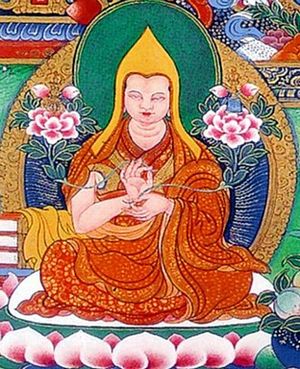Kangyur

Kangyur (Tib. བཀའ་འགྱུར་, Wyl. bka' 'gyur) literally means the 'translated words' of the Buddha. The Kangyur is a collection of the Buddha's own teachings in their Tibetan translation. The words of the Buddha comprise both the sutras and the tantras.
The parent collection of the Kangyur is the Tengyur that gathers the treatises composed by the great Indian masters of the first millennium in Tibetan translation. Though these collections aimed at exhaustiveness, most Nyingma tantras were left out by their Sarma compilers. This lead to the creation of the Nyingma Gyübum that brings together the Nyingma tantras.
The compilation of the first version of the Kangyur was finalized by the great scholar Butön Rinchen Drup (1290-1364). Several versions of the compilation existed in Tibet, among which the most notable are those from Dergé, Lhasa, Narthang, Choné, Peking, Urga, Phudrak, and Tok Palace. Before the compilation work started, most of the texts in these collections existed in several translations. The editors chose the one they considered the best. While the 'chosen one' became authoritative, most of the other ones disappeared. The different editions mostly show minor variations in the texts collected.
Divisions of the Dergé Kangyur
- The Discipline (Skt. Vinaya; Tib. འདུལ་བ་, Wyl. 'dul ba) section (Toh 1-7) contains texts focusing primarily on the monastic rules and their origins, but also a wealth of historical, biographical, and cultural material.
- The Discourses (Skt. Sūtra; Tib. མདོ་, Wyl. mdo) section (Toh 8-359) forms the main body of the Buddha’s discourses, ranging from lengthy and detailed presentations of doctrine to brief summaries of particular points.
- The Incantations (Skt. Dhāraṇī; Tib. གཟུངས་, Wyl. gzungs) section (Toh 846-1108) contains short sutra or tantra texts used mainly for ritual purposes, mostly structured around an incantation in Sanskrit, its uses and the story of its origin.
Further Reading
- Paul Harrison, 'A Brief History of the Tibetan bKa' 'gyur' in Cabezón and Jackson, ed., Tibetan Literature: Studies in Genre, Snow Lion, 1996
- Peter Skilling, Translating the Buddha's Words: Some Notes on the Kanjur Translation Project, Nonthaburi, March 11, 2009
- Peter Skilling, 'Kanjur Titles and Colophons' in Tibetan Studies, vol. 2. Oslo, 1994, pp.768-780
Internal Links
External Links
 Translations of the Word of the Buddha at 84000
Translations of the Word of the Buddha at 84000 Words of the Buddha
Words of the Buddha བཀའ་འགྱུར། ༼ཅོ་ནེ༽
བཀའ་འགྱུར། ༼ཅོ་ནེ༽ བཀའ་འགྱུར། ༼སྡེ་དགེ༽
བཀའ་འགྱུར། ༼སྡེ་དགེ༽ བཀའ་འགྱུར། ༼སྣར་ཐང་༽
བཀའ་འགྱུར། ༼སྣར་ཐང་༽ བཀའ་འགྱུར། ༼ལྷ་ས༽
བཀའ་འགྱུར། ༼ལྷ་ས༽- Tibetan Canonical Works at the TBRC
- Electronic versions of the Kangyur at asianclassics.org (ACIP)
- Online searchable Kangyur
- Dr. John Canti: 'The Kangyur: Holy Relic, Time Capsule, or Goldmine?' (in three parts)